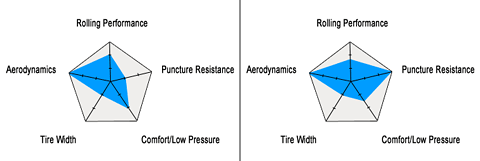

New, Full-Treaded Tires Generate More Rolling Resistance Than Shallow-Treaded, Worn Tires
Tire rolling resistance gradually drops by about 20% during the life of a tire as the tread wears from its original molded depth to worn out. This can be attributed to the reduction in tread mass and rubber squirm, as well as subtle hardening of the tread compound during years of service and exposure to the elements.
While this gradual reduction in tire rolling resistance and minor increase in fuel economy may be too subtle to register during the tire's life on a tank-by-tank basis, the virtually instantaneous switch from worn tires to new tires (even if they are the same brand, type and size) will typically result in an increase in rolling resistance of about 20%. Since the automotive industry estimates a 10% increase in tire rolling resistance will result in a 1% to 2% decrease in vehicle fuel economy, drivers should expect to experience a potential 2% to 4% decrease in mpg.
New, Full-Treaded Tires Travel Farther per Tire Revolution Than Shallow-Treaded, Worn Tires
Vehicles are programmed with their Original Equipment (O.E.) tire's revolutions-per-mile to allow their odometers to calculate the distances traveled. Unfortunately vehicle odometers aren't always 100% accurate and the tire revolutions per mile will change as its tread wears.
The diameter and circumference of a new, full-treaded tire is greater than that of an old, worn-out tire. Considering that many passenger car tires are molded with beginning tread depths of 10/32" to 12/32", the tires will be approximately 1/2" to 6/10" shorter in diameter when they've worn to the minimum tread depth of 2/32".
In order to determine how much odometer error this dimensional difference might cause, the Tire Rack team drove one of our 2008 BMW 328Ci test cars on a set of new, full-treaded 205/55R16-sized tires, as well as another set of the same tires shaved to worn-out (2/32") tread depth. We used a Global Positioning System (GPS) to measure the 100-mile test distance on a dry Indiana Toll Road and maintained an average speed of 70 mph. We then compared the number of miles traveled indicated by the vehicle's odometer to the GPS receiver and highway mile markers.
When the GPS indicated exactly 100 miles had been traveled while the vehicle was equipped with new 12/32" deep tires, the vehicle's odometer registered 99.4 miles. When the vehicle was then equipped with another set of the same tires shaved to 2/32" of remaining tread depth, the odometer indicated 101.0 miles. While the 100-mile test distance didn't change, essentially the vehicle's odometer overstated the distance traveled by about 1.5% when equipped with the worn out tires.
Since drivers traditionally monitor their vehicle's fuel economy by dividing the number of miles traveled as registered on the odometer by the number of gallons used to fill the tank (or by simply letting the vehicle's trip computer handle the task), the accuracy of the vehicle's fuel economy calculation is dependant on the number of miles indicated by the odometer.
This means that the vehicle's fuel economy (whether calculated by the driver after filling up or the trip computer) would instantaneously appear to drop by about 1.5% when fitted with new tires simply because the vehicle would actually have traveled 1.5% farther than it did when equipped with its recently removed worn-out tires.
Not All Tire Dimensions are Created Equal
Even though tires may be branded as the same size, their specifications may vary slightly by manufacturer and tire line. Tire Rack has seen the overall diameter of a single passenger car tire size vary by 2/10" from the smallest to the largest.
As an example, we'll compare the differences between an O.E. tire with two replacement tires in the 185/65R15 size used on the 2008 Toyota Prius,
| Diameter | Tread Depth | Tire RPM* | |
|---|---|---|---|
| Goodyear Integrity (O.E.) | 24.4" | 10/32" | 855 |
| Yokohama AVID TRZ | 24.4" | 11/32" | 850 |
| General Altimax RT | 24.5" | 11/32" | 843 |
| *Tire revolutions per mile | |||
As shown above, there are slight differences between the tires' published diameters, tread depths and tire revolutions per mile. However, if a tire rolls fewer times per mile than the tire it replaces, the vehicle will again actually be traveling farther than is indicated by the odometer. Calculating the influence of the different tire specifications on the vehicle's odometer would indicate the Yokohama AVID TRZ would travel .6% farther than the Goodyear Integrity, while the General Altimax RT would travel 1.4% farther.
Conclusion
While many of these individual differences may seem insignificant, it is easy to understand that when they are added together, the new tires may appear to reduce vehicle fuel economy. It also means that a Toyota Prius appearing to get 50.0 mpg just before replacing its worn-out tires with new tires of the same brand, type and size, might be reduced to registering just 47.25 mpg afterwards, even if all of the driving conditions were identical.
Remember, "your mileage may vary."
No comments:
Post a Comment